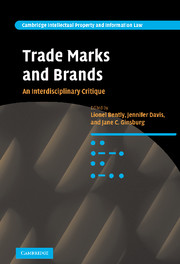Book contents
- Frontmatter
- Contents
- List of figures and tables
- Notes on the contributors
- Editors' preface
- Table of cases
- Table of statutes
- Part I Legal and economic history
- Part II Current positive law in the EU and the USA
- Part III Linguistics
- Part IV Marketing
- Part V Sociology
- Part VI Law and Economics
- Part VII Philosophy
- 13 Trade marks as property: a philosophical perspective
- 14 An alternative approach to dilution protection: a response to Scott, Oliver and Ley-Pineda
- Part VIII Anthropology
- Part IX Geography
- Bibliography
- Index
- Titles in the series
14 - An alternative approach to dilution protection: a response to Scott, Oliver and Ley-Pineda
Published online by Cambridge University Press: 13 April 2010
- Frontmatter
- Contents
- List of figures and tables
- Notes on the contributors
- Editors' preface
- Table of cases
- Table of statutes
- Part I Legal and economic history
- Part II Current positive law in the EU and the USA
- Part III Linguistics
- Part IV Marketing
- Part V Sociology
- Part VI Law and Economics
- Part VII Philosophy
- 13 Trade marks as property: a philosophical perspective
- 14 An alternative approach to dilution protection: a response to Scott, Oliver and Ley-Pineda
- Part VIII Anthropology
- Part IX Geography
- Bibliography
- Index
- Titles in the series
Summary
Introduction
The chapter by Scott, Oliver and Ley-Pineda makes a powerful case against both utilitarian and Lockean justifications of the protection of trade marks against ‘dilution’ or, as I prefer it, protection against ‘allusion’ to the mark. In so doing, they reinforce a common scepticism about this type of protection. To that extent, the chapter makes a significant contribution to our understanding of trade mark law.
There are, of course, claims of detail in the chapter with which I disagree. For example, the authors' discussion of the object of an intellectual property right fails adequately to take account of either the structure of the relevant regimes, or the ways in which they develop. Thus section 60(1) of the Patent Act 1977 introduces a list of potentially infringing uses of an invention with the words ‘… a person infringes a patent if, but only if, … he does any of the following things’. Section 16(1) of the Copyright, Designs and Patents Act 1988 introduces a similar, but more specific, list with the words ‘[t]he owner of the copyright in a work has … the exclusive right to do the following acts in the United Kingdom’. The clear implication is that if a patent holder or copyright owner has ‘an open-ended set of use-privileges, control powers and powers of transmission’, they relate, not to the invention or the work, but to the legal right that is the patent or the copyright.
- Type
- Chapter
- Information
- Trade Marks and BrandsAn Interdisciplinary Critique, pp. 306 - 316Publisher: Cambridge University PressPrint publication year: 2008
- 1
- Cited by



